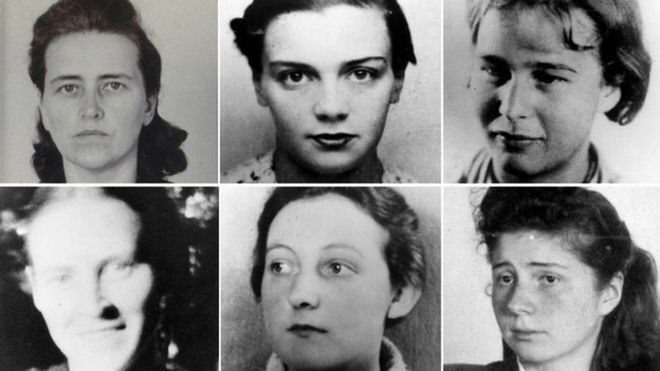Berlin to bury prisoners' tissue kept by Nazi-era doctor
1 hour ago

GERMAN RESISTANCE MEMORIAL CENTER, GDW
Some of the women whose bodies were used by Stieve (pic: GDW)
More than 300 tiny pieces of human tissue from prisoners executed in Nazi-era Berlin will be buried on Monday.
The samples were found in microscopic slides at a property that belonged to Hermann Stieve - an anatomy professor at the Charité university hospital.
Heirs of the doctor, who died in 1952, discovered the collection in 2016.
Researchers say Stieve systematically collaborated with the Nazis to receive the bodies of 184 people, mostly women, executed for political resistance.
More:
https://www.bbc.com/news/world-europe-48215894
https://bilder.bild.de/fotos-skaliert/professor-hermann-stieve-horror-nachlass-von-nazi-arzt-entdeckt-201104584-61232162/4,w=993,q=high,c=0.bild.jpg
Professor Hermann Stieve
~ ~ ~
NOV. 6 2013 5:50 AM
The Nazi Anatomists
How the corpses of Hitler's victims are still haunting modern science—and American abortion politics.
By Emily Bazelon
“Sources of Material”
In 1941, Charlotte Pommer graduated from medical school at the University of Berlin and went to work for Hermann Stieve, head of the school’s Institute of Anatomy. The daughter of a bookseller, Pommer had grown up in Germany’s capital city as Hitler rose to power. But she didn’t appreciate what the Nazis meant for her chosen field until Dec. 22, 1942. What she saw in Stieve’s laboratory that day changed the course of her life—and led her to a singular act of protest.
Stieve got his “material,” as he called the bodies he used for research, from nearby Plötzensee Prison, where the courts sent defendants for execution after sentencing them to die. In the years following the war, Stieve would claim that he dissected the corpses of only “dangerous criminals.” But on that day, Pommer saw in his laboratory the bodies of political dissidents. She recognized these people. She knew them.
On one table lay Libertas Schulze-Boysen, granddaughter of a Prussian prince. She’d been raised in the family castle, gone to finishing school in Switzerland, and worked as the Berlin press officer for the Hollywood studio Metro-Goldwyn-Mayer. She joined the Nazi Party in 1933. On a hunting party, she flirted with Hermann Göring, commander of the Luftwaffe, the German air force. But in 1937 Schulze-Boysen joined the resistance with her husband, Harro, a Luftwaffe lieutenant. They helped form a small rebel group the Nazis called the Red Orchestra. When Libertas started working for Hitler’s movie empire in 1941, she gathered photos of atrocities from the front for a secret archive. Harro was transferred to Göring’s command center and with other dissidents started passing to the Soviets detailed information about Hitler’s plan to invade Russia. The Gestapo decoded their radio messages in 1942 and arrested Harro at the end of August. They came for Libertas eight days later. Both she and her husband were sentenced to death for espionage and treason.
Now Harro’s body lay on another table in the lab. Pommer could see that he had been hanged and Libertas had been decapitated by guillotine. On a third table, Pommer identified Arvid Harnack, another member of the Red Orchestra who had been a key informant for the American Embassy as well as the Soviets. In the 1920s, Harnack had studied economics as a Rockefeller Fellow at the University of Wisconsin, where he wandered into a literature class by mistake and met a young American teaching assistant named Mildred Fish. They traded English and German lessons and got married on her brother’s farm. After the couple moved to Germany, Mildred also helped the resistance effort by carrying messages and trailing her husband to meetings to make sure he wasn’t being followed. They were caught in the same Gestapo operation that ensnared the Schulze-Boysens. "Can you remember Picnic Point, when we got engaged?” Arvid asked his wife in his final letter to her from prison. “And before that our first serious talk at lunch in a restaurant in State Street? That talk became my guiding star.” At the time, Mildred was serving a six-year sentence for her part in the Red Orchestra. Before he was executed, Arvid wrote to his family about his joy that her life had been spared. But Hitler refused to accept the sentence, and Mildred, too, would be beheaded on his order two months later.*
More:
http://www.slate.com/articles/life/history/2013/11/nazi_anatomy_history_the_origins_of_conservatives_anti_abortion_claims_that.html